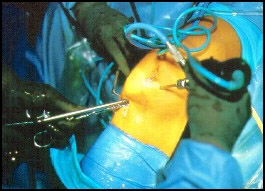Arthroscopic knee surgery (arthroscopy) is a procedure orthopedic surgeons use to look, diagnose and treat problems inside the knee joint. Arthroscopic surgery requires the use of anaesthetics and special equipment and is performed in a hospital operating room or out-patient surgical suite.
The arthroscope is a pencil-sized instrument that contains a small lens and lighting system that allows the surgeon to magnify and shine light on structures inside the knee joint. The arthroscope is inserted into the knee joint by small incisions in the skin around the knee. The arthroscope is attached to a miniature television camera which shows the inside of the knee on a television screen. This allows the surgeon to look at the joint surfaces of the knee, cartilage and ligaments, and under the knee cap. Other small instruments can be inserted into the knee to probe, remove and/or repair damaged structures in the knee if necessary.

Why is knee arthroscopy necessary?
Diagnosing knee joint injuries begins with a detailed medical history, physical examination and usually x-rays. In some cases additional tests such as a bone scan, CT scan or MRI may also be needed. The arthroscope allows direct visualization of the inside of the knee and is accurate in determining injury or disease inside the knee. Some of the most frequent conditions found during arthroscopy of the knee joint are: meniscus injuries, ligament injuries and loose pieces of bone and/or cartilage. The lining of the knee joint can also be inspected.
After arthroscopic surgery the small incisions are covered with a dry dressing. These small incisions will heal over several days. Before leaving the hospital or surgical suite, you will be given instructions about care for your incisions and what activities you should avoid and which exercises you should do to aid your recovery. During a follow up visit the surgeon will inspect your incisions, discuss what was done and discuss your rehabilitation program.
The amount of surgery required and recovery time will depend on the complexity of your knee problem. Occasionally during arthroscopy the surgeon may discover that the injury or disease cannot be treated adequately with arthroscopy alone. More extensive surgery may be performed while you are still anaesthetized or at a later date after you discuss the findings with your surgeon.
What is the recovery like after knee arthroscopy?
Recovery time after arthroscopy depends on what was found and done during the procedure. A specific activity and rehabilitation program may be suggested to speed recovery and protect further knee joint function. Some people go back to work or school or resume daily activities within a few days. Athletes and others who are in good physical condition often return to athletic activities within a few weeks but occasionally it takes several weeks to recover maximally. People who have knee arthroscopy can have many different problems so each patient’s recovery time will vary.
What are the possible complications of knee arthroscopy?
Complications from arthroscopy are uncommon but occasionally occur during or after the procedure. Infection, blood clots in the veins of the leg, excessive swelling or bleeding and damage to the blood vessels or nerves are some of the problems that can occur. Your surgeon will assess and explain the advantages and disadvantages prior to proceeding with arthroscopy.
